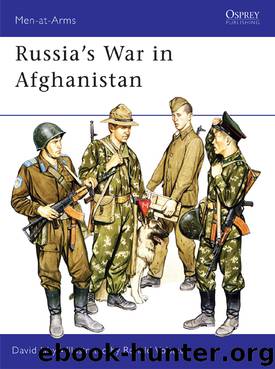Russia's War in Afghanistan by David Isby

Author:David Isby
Language: eng
Format: epub
Tags: Russia’s War in Afghanistan
ISBN: 9781472801791
Publisher: Bloomsbury Publishing
A T-62A tank of the DRA Army takes part in a Revolution Day parade in Kabul; cf. Plate B for turret markings, and note the added Soviet parade strips on the trackguards. The DRA’s T-62 force is normally based at Pul-e-Charki near Kabul; on 27 December 1979 they were coincidentally immobilised by Soviet advisors, who removed the batteries ‘for winterisation’.
Major Resistance Groups
Mohaz Melli Islami The National Islamic Front of Afghanistan, led by Pir Sayid Ahmed Gailani. Pro-Western in outlook, NIFA is strongest around Khandahar and among the Pathans of the border areas, from Badakhshan down to Ghazni and west to Wardak and Kabul, based on the Pir’s status as a Qadiriya Sufic religious leader. Pro-royalist, this group believes the return of the king (by 1986, an unlikely event) would provide needed unity.
Jebhe Milli Nejad The National Liberation Front of Sibghtullah Modjaddidi. Pathan and Naqshbandi Sufic, this traditionalist group, though the smallest of the major parties, is strong in the Jalalabad, Logar, and Khandahar areas. While the leadership was anti-royalist pre-war, there is pro-king sentiment among the rank and file.
Harakat-i-Inquilabi-i-Islami The Islamic Revolutionary Movement of Mohammed Nabi Mohammedi. Numerically strong, Harakat represents much of the spirit of traditional Afghanistan. Village-based, its leaders are local mullahs. It lacks the Sufi background of other traditionalist parties. Strongest amongst Pathans and Uzbeks, with widespread support, especially in Ghazni, Wardak, Koh-i-Safi, Badakhshan and Kunar. Numbers declined in 1985.
Hezbi-i-Islami The Islamic Party of Younis Khalis. Khalis is a moderate fundamentalist, strongest among Pathans. He was formerly associated with the other Hezb party. Kabul, Nangarhar and Paktika provinces have a strong Khalis presence. Khalis himself regularly fights inside Afghanistan. Rapid growth in 1985; this party is known for hard and effective fighting.
Jamiat-i-Islami The Islamic Society of Prof. Burhanuddin Rabbani. A moderate fundamentalist group, Jamiat is numerically large, and strongest among the Tadjiks, Uzbeks and Turkomen. Making use of the non-tribal nature of Tadjik society—unlike that of the Pathans—Jamiat has benefitted from having the most effective regional commanders in Dari-speaking areas. Anti-royalist, but not anti-Western in outlook, Jamiat has been attacked by more extreme fundamentalists, with Khalis being its closest ally. Jamiat has attracted Pathan supporters, especially in Paktia and the Jagdalak Valley of Nangarhar. Active throughout Dari-speaking Afghanistan; Herat Mazar-e-Sharif, Badakhshan, Takhar, Parwan, and Kapisa provinces have Jamiat strongholds.
Ittehad-e-Islami The Islamic Alliance of Prof. Abdul Rasoul Sayeff, who in 1982 became chairman of the Fundamentalist Alliance due largely to his access to money and weapons through his links with Moslem Brotherhood and Wahabi groups in the Arab world. He attracted many guerrillas in 1982–84; but because of his lack of a firm, traditional base of authority except in parts of his native Paghman region, many have left with their arms. He also has some influence in Kabul, Nangarhar, Paktika, and Paktia.
Hezb-i-Islami The Islamic Party of Gulbuddin Hekmatyar. The most controversial Peshawar-based party leader, Hekmatyar was one of the first to take up jihad and so had many adherents. He has since been accused of being more concerned with seizing power post-war and of co-operating with the Soviets.
Download
This site does not store any files on its server. We only index and link to content provided by other sites. Please contact the content providers to delete copyright contents if any and email us, we'll remove relevant links or contents immediately.
| Automotive | Engineering |
| Transportation |
Whiskies Galore by Ian Buxton(40518)
Introduction to Aircraft Design (Cambridge Aerospace Series) by John P. Fielding(32348)
Small Unmanned Fixed-wing Aircraft Design by Andrew J. Keane Andras Sobester James P. Scanlan & András Sóbester & James P. Scanlan(32148)
Craft Beer for the Homebrewer by Michael Agnew(17463)
Turbulence by E. J. Noyes(7059)
The Complete Stick Figure Physics Tutorials by Allen Sarah(6650)
Kaplan MCAT General Chemistry Review by Kaplan(6067)
The Thirst by Nesbo Jo(5795)
Bad Blood by John Carreyrou(5784)
Learning SQL by Alan Beaulieu(5427)
Weapons of Math Destruction by Cathy O'Neil(5049)
Man-made Catastrophes and Risk Information Concealment by Dmitry Chernov & Didier Sornette(4750)
iGen by Jean M. Twenge(4708)
Digital Minimalism by Cal Newport;(4572)
Life 3.0: Being Human in the Age of Artificial Intelligence by Tegmark Max(4521)
Audition by Ryu Murakami(4107)
1,001 ASVAB Practice Questions For Dummies by Powers Rod(4046)
Electronic Devices & Circuits by Jacob Millman & Christos C. Halkias(4046)
Pale Blue Dot by Carl Sagan(4018)
